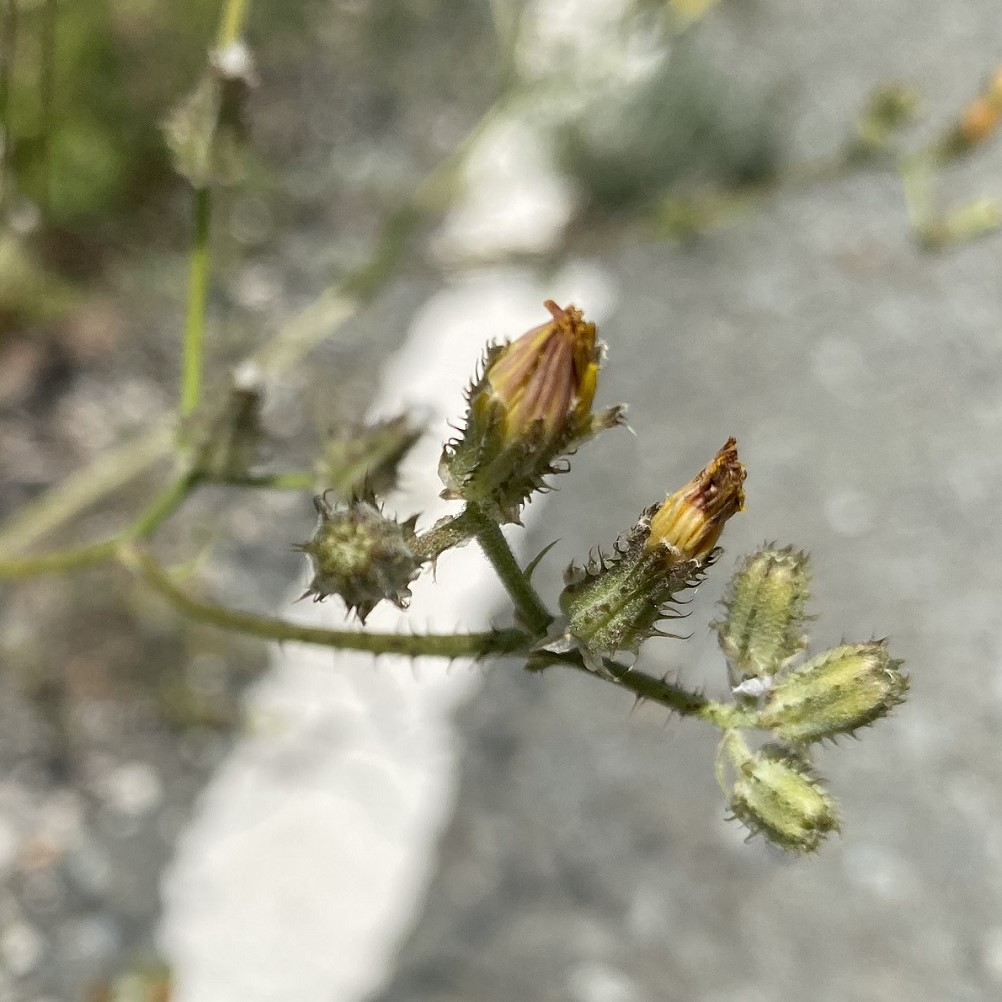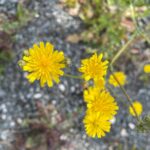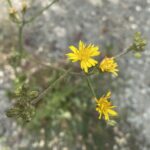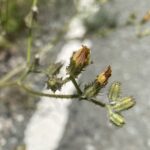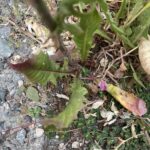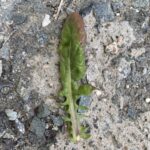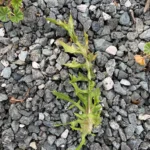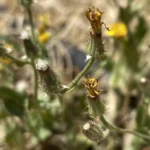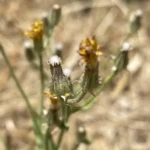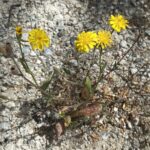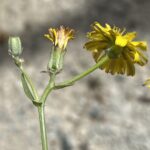Κρηπίδα η τραχεία
Etymology of Crepis aspera
The name "Crepis" derives from the Ancient Greek "κρηπίς" which is "a platform, the base with stairs, on which the temples were built in ancient Greece", because of the formation of its leaves on where the stems with the flowers stand in some species of the genus. Latin female "aspera" means "rough", referring to the rough-haired or spined stems and flowers of the species.
The Crepis genus in Cyprus
In Cyprus, we encounter 9 species and two subspecies (11 taxa).
Crepis aspera in Cyprus
Crepis aspera is a common plant in Cyprus, it is encountered all around the island, except in the central plains of Mesaoria, the mountains exceeding 1150 metres, the northwestern and central-northern Cyprus. It is found up to an altitude of up to 1150 metres. Crepis aspera blooms between March and June.
Crepis aspera morphology characteristics
Basal leaves
The lower cauline leaves of Crepis aspera exhibit a range of shapes, being narrowly ovate, narrowly obovate, or oblong. These leaves are characterized by a glaucous coloration. The surface of the leaves ranges from glabrous to hispid, often displaying yellowish or black-based bristles. Additionally, the plant exhibits spinescence on its leaves. Some observations also note the presence of scattered short whitish hairs on both leaf surfaces, particularly on the underside of the midrib. In terms of size, the lower cauline leaves typically measure between (2.0)-4.0-14.0-(24.0) cm in length and (0.5)-1.0-4.0-(5.0) cm in width. These leaves are pinnatifid with denticulate margins, and their apices can be either obtuse or acute. They are amplexicaul and auriculate at the base, with lateral lobes that are either oblong or deltoid. It is also noteworthy that not all leaves in this species are basal. The variability in leaf shape and hairiness suggests a degree of phenotypic plasticity, potentially influenced by environmental conditions or reflecting different stages of plant development. The presence of both glabrous and hispid forms indicates a possible range of expression for this trait within the species.
Stem leaves
The stem leaves of Crepis aspera are alternate and can be entire, dentate, or serrate, and they are also spinescent. The middle and upper cauline leaves become progressively more divided, transitioning to a pinnatisect-laciniate form and eventually reducing to scales as they ascend the stem. The uppermost leaves are smaller, sessile, triangular in outline, and acute. Similar to the basal leaves, the stem leaves range from glabrous to hispid, bearing yellowish or black-based bristles. The presence of scattered short whitish hairs, especially on the lower midrib, is also noted. The stem leaves are amplexicaul to auriculate at their base. The presence of stem leaves that become increasingly divided and reduced in size towards the apex is a characteristic feature of this species, mirroring the hair characteristics observed in the basal leaves.
Inflorescence
The inflorescence of Crepis aspera is characterized by pedunculate capitula. Several capitula are arranged in spreading branches forming the synflorescence. The peduncles are relatively short, measuring 5-10(-20) mm in length, and they exhibit a notable change as the fruit develops, becoming thick and rigid. However, some sources report the peduncles reaching up to 4.0 cm in length. The peduncles themselves bear sparse bristles or can be ± hispid. The short peduncles that become rigid in fruit are a distinctive feature, although the reported variation in length might reflect different growth stages or environmental influences.
Flowers
Its name "aspera" is Latin for "rough," a clear nod to the plant's notably coarse and bristly texture, evident on its leaves and stems, and extending to its floral structures. The flowers, typical of the Asteraceae family, are presented in capitula (flower heads), contributing to the plant's overall spiny appearance.
Flowers' peduncles
The flower heads of Crepis aspera are numerous and borne on pedunculate (stalked) capitula, arranged in a branched inflorescence. The peduncles are relatively short, typically measuring between 5 and 20 mm, though they can occasionally reach up to 4.0 cm. These peduncles are characterized by the presence of sparse bristles, contributing to the plant's rough feel. A distinctive feature is that these peduncles become notably thick and rigid as the fruits (achenes) develop. Each capitulum is relatively large for the genus, containing a significant number of florets, usually ranging from 50 to 100 or even more per head.
Flowers' involucre and bracts (phyllaries)
The involucre, the cup-like structure subtending the florets, is campanulate (bell-shaped) during flowering. It is composed of two series of bracts or phyllaries: an outer and an inner. The outer involucral bracts are highly distinctive among the Crepis species. They are unequal in size, spreading or reflexed, "papery", glabrous or glandular-hairy. They are around 3.0 mm long and 2.0 mm wide, with an acute tip and scarious (dry, membranous) margins [Margin: This just means the edge or border of something. So, the "margins" of the inner phyllaries are their edges. Scarious: This is the key botanical term here. When a plant part is described as scarious, it means it is dry, thin, and papery or membranous. It's not green and leafy or fleshy like most plant tissue. It's often somewhat translucent or pale brown/white]. The inner involucral bracts are longer, approximately 6.0 mm long and 2.0-2.5 mm wide, narrowly ovate with an acute apex and scarious margins. The inner bracts of Crepis aspera bear stiff bristles or tiny, tough spikes*. They aren't soft or woolly, but rather rough to the touch. They are notably hispid along their prominent, often keeled midribs [the midrib is just the main line or vein running right down the center of that bract, from base to tip. When something is described as keeled it means it has a distinct, raised ridge running along it. So, a keeled midrib means that the central line on the inner bract isn't just a flat vein; it stands out as a noticeable ridge or bump. This ridge is often quite prominent, and on Crepis aspera, it's particularly along this raised central line that you find those stiff, bristly hairs that give the plant its "rough" name. So, the inner bracts having a raised "spine" down the middle that is covered in coarse hairs]. The contrast in size, form, and hairiness between the outer and inner bracts is a very essential key feature of the involucre in Crepis aspera.
*In some pictures below, you will see some exceptions for the spikes/bristles on the inner bracts.
Florets and corolla tube
All the florets within the capitulum are ligulate, meaning they possess a strap-shaped limb (ligule). These ligulate florets are bright yellow. The corolla consists of a tube and the ligule (the ligule is the strap-shaped, flattened part of the corolla in each floret within the flower head). The corolla tube is about 3.0 mm long, and the ligule, which constitutes the visible "petal," is approximately 7.0 mm long and 2.0 mm wide. The outer face of the ligules is often tinged with red. The corolla is described as sparsely pilose, indicating the presence of scattered soft hairs on the surface of the petals or the tube.
